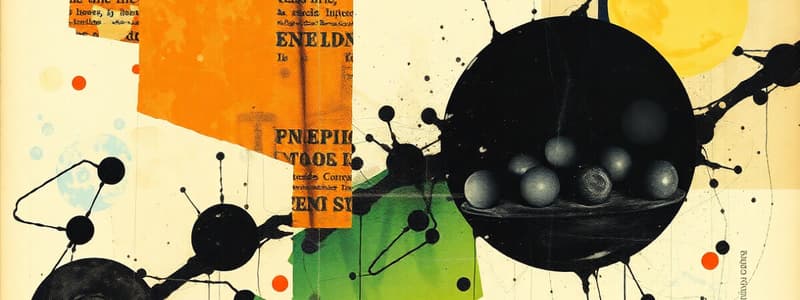Podcast
Questions and Answers
What is the total amount of crystallized A expected after the recrystallization process?
What is the total amount of crystallized A expected after the recrystallization process?
- 2.0 g
- 0.15 g
- 1.85 g (correct)
- 0.4 g
Which solvent can be used for the recrystallization of the unknown compound according to the procedure?
Which solvent can be used for the recrystallization of the unknown compound according to the procedure?
- Methanol
- Acetone
- Water (correct)
- Ethanol
What is the maximum solubility of Acetanilide in cold water as provided in the data?
What is the maximum solubility of Acetanilide in cold water as provided in the data?
- 0.54 g/100 mL (correct)
- 5.0 g/100 mL
- 0.076 g/100 mL
- 1.22 g/100 mL
What should be done with the solid waste after the experiment?
What should be done with the solid waste after the experiment?
Why is it necessary to use boiling chips or a stir bar when boiling water?
Why is it necessary to use boiling chips or a stir bar when boiling water?
What is the primary purpose of recrystallization in the laboratory?
What is the primary purpose of recrystallization in the laboratory?
How does temperature affect the solubility of compounds during recrystallization?
How does temperature affect the solubility of compounds during recrystallization?
What occurs to impurities in a mixture during the recrystallization process?
What occurs to impurities in a mixture during the recrystallization process?
What observation would indicate a compound is pure after recrystallization?
What observation would indicate a compound is pure after recrystallization?
Given the solubilities in boiling solvent for Compound A (4.0 g/100 mL) and Compound B (6.0 g/100 mL), how much boiling solvent is required to dissolve 2.0g of Compound A?
Given the solubilities in boiling solvent for Compound A (4.0 g/100 mL) and Compound B (6.0 g/100 mL), how much boiling solvent is required to dissolve 2.0g of Compound A?
If 50 mL of boiling solvent is added to a mixture containing 2.0g of A and 0.3g of B, how much of Compound B could dissolve in that volume?
If 50 mL of boiling solvent is added to a mixture containing 2.0g of A and 0.3g of B, how much of Compound B could dissolve in that volume?
What is the appropriate method to recover the crystallized solid after cooling the solution during recrystallization?
What is the appropriate method to recover the crystallized solid after cooling the solution during recrystallization?
Which factor is NOT typically associated with broad melting point ranges in solids?
Which factor is NOT typically associated with broad melting point ranges in solids?
Study Notes
Experiment 3: Purification and Identification of an Unknown Solid
- Key Lab Skills and Techniques: Recrystallization and measuring melting points
- Key Concepts:
- Recrystallization: Based on the difference in solubility of a solid in hot vs cold solvent.
- Dissolving the solid in a minimal amount of boiling hot solvent.
- Cooling the solution, leading to crystallization of the dissolved solid as solubility decreases.
- Impurities are removed through filtration, either dissolved in the cold solvent or removed from the hot solvent.
- Pure solids have a sharp melting point range (usually 2 degrees or less).
- Melting Point: A characteristic property of pure substances.
- Broad melting point ranges indicate impure compounds.
- Recrystallization: Based on the difference in solubility of a solid in hot vs cold solvent.
Recrystallization Procedure
- Procedure: Recrystallize the unknown solid from last week using water.
- Important: Carefully read the section on recrystallization in "Organic Chemistry Lab Techniques" by Nichols.
- Procedure: Measure the melting point of:
- The purified unknown.
- The unknown mixed with acetanilide.
- The unknown mixed with phenacetin.
Recrystallization Example with Compounds A & B
- Solubility: Compound A and B have different solubility in hot and cold water.
- Example: 2.0 g of Compound A and 0.3 g of Compound B in a mixture.
- 50mL of boiling water is required to dissolve all of Compound A.
- 3.0g of Compound B could dissolve in 50 mL of boiling water.
- After cooling, 0.15 g of Compound A and 0.4 g of Compound B remain soluble in the cold solvent.
- Crystallization: 1.85 g of Compound A crystallizes out of the solution (2.0 g - 0.15 g = 1.85 g).
- Example: 2.0 g of Compound A and 0.3 g of Compound B in a mixture.
Chemical Used
- Acetanilide and Phenacetin: Two compounds used in the experiment.
- Both have different solubility in hot and cold water.
Safety Considerations
- Hot Surfaces: Exercise caution to avoid burns.
- Boiling Water: Use boiling chips or a stir bar to prevent bumping.
Results
- Results: Record:
- Mass of the unknown before and after recrystallization
- % purity of the unknown from last week
- Melting point of the pure unknown
- Melting points of the mixtures (unknown with acetanilide and unknown with phenacetin)
Waste Disposal
- Acetanilide and/or Phenacetin: Solid waste container.
- Filtrate: Aqueous waste container.
- Acetone: Organic waste container.
Studying That Suits You
Use AI to generate personalized quizzes and flashcards to suit your learning preferences.
Description
This quiz focuses on the key lab skills and techniques for the purification and identification of an unknown solid through recrystallization and melting point measurement. You will explore the differences in solubility and the importance of sharp melting point ranges in determining purity.




